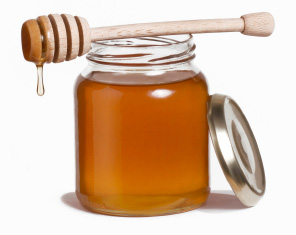 According to a test run by Food Safety News, a vast majority of the honey lining grocery store shelves may not actually be honey.
According to a test run by Food Safety News, a vast majority of the honey lining grocery store shelves may not actually be honey.
Results of the study showed that the pollen typically found in honey is often filtered out through a high-tech procedure called ultra-filtering. Without this pollen, it’s difficult to identify where the honey in question originated from and whether it is in its purest form. From plastic bears to jugs and jars, it can be a real challenge to identify which products are your best bet. To help you out, here are a few guidelines to help you select real honey every time:
What you need to know
With a vast majority of our honey being ultra-filtered, it’s important to know what that means. In some instances, it may mean that there is indeed very minimal amounts of real honey present within the product; however, in most cases it most likely means that the purity of the honey isn’t as clear cut as you thought it might be. According to the study done by Food Safety News, most of the honey lining our grocery store shelves have had their pollen removed. In fact, 76-100% of the samples retrieved from some of America’s biggest grocery store chains tested negative for pollen.
In response, some companies have claimed that they remove the pollen, along with additional debris common in the collection of honey, to provide consistently clearer honey to consumers. Nevertheless, many believe that this associated debris could be removed without hampering the pollen content. Whether this is true or not, the bigger issue is that when the pollen is filtered out, it becomes difficult to identify contaminated honey from the full-fledged, good-for-you stuff. Recently, Europe banned Indian honey since it was deemed unsafe due to the antibiotic and heavy metal contaminants found in another recent study by Food Safety News. Without the pollen intact, separating the safe from the unsafe became almost impossible.
What you need to look for
Although not all honey is fake, the likelihood of it not containing pollen is probably pretty high. If you are concerned about this and want to make sure that the honey you are getting is real, you have a couple different options. First, you could consider buying organic honey at your grocery store. Although some organic honey has also undergone the ultra-filtering process, over 70% typically had its pollen intact according to the Food Safety News study. Second, consider purchasing honey locally. 100% of the honey tested from farmers markets, co-ops and natural stores like Trader Joe’s had their pollen intact.
 Why you should be choosing real honey over fake honey
Why you should be choosing real honey over fake honey
But it all tastes sweet, right? Well, yes, but there is a lot more to honey than meets the eye and it is important to consider what makes pollen-containing honey a superior choice.
For years, honey has been known to have many wonderful health supporting properties. In large part, this is due to the phytonutrients present in its natural form. These components have been shown to have cancer preventing and anti-tumor properties. Certain studies have also shown that various types of honey can reduce coughing in children ages 2 to 18 with upper respiratory infections. It is important to note though that children under the age of one year should not be given honey because of the potential risk of botulism associated with it. Additional studies have also linked honey to improved wound healing, better physical performance, decreased free radical movement, cholesterol and type 2 diabetes risk reduction.
Ultra-filtered honey, on the other hand, has less health benefits. In fact, the pollen of honey is what most attribute these health benefits to. Without the pollen, you are left with the sugary sweetness, but the bitterly truth of less than ideal nutritional quality. Additionally, if the product is almost completely artificial, you may find that you aren’t getting much of anything except a few extra empty calories.
What is being done to keep honey safe
Although the FDA is currently not getting involved in the great honey debate, many groups and organizations are working diligently to ensure that the honey we are eating is intact. In July 2025, Florida adopted a pure honey standard and placed its Division of Food Safety in the Department of Agriculture and Consumer Affairs enforcing it. Since then, three other states have enacted a similar standard in an effort to keep honey as safe as it possibly can be. In addition, 12 more states are looking at adopting a similar standard too.
Bottom Line
Although many of the honey varieties in your store may not be all they claim to be, there are options available to help you enjoy the honey you love without having to worry whether what you are eating is real or not. Seek out organic and local honey options where you can and enjoy honey for all its health benefits and varieties.
Also Read:
